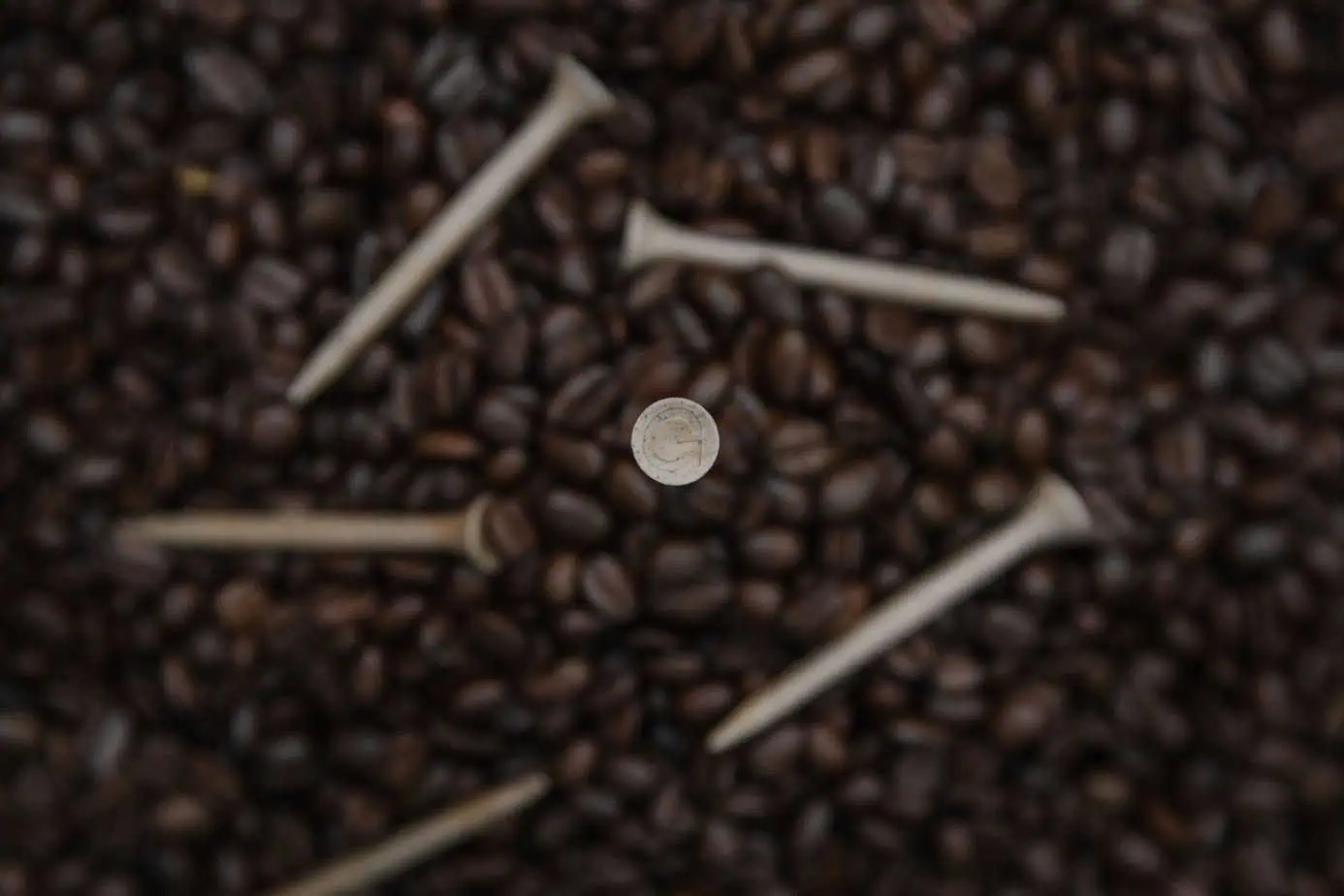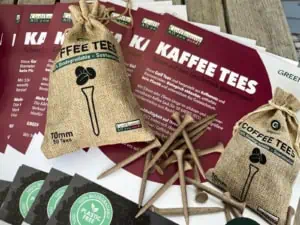Circular economy: coffee tees pass the test
A quick espresso before the tournament. The cappuccino after the round. Iced coffee on the terrace. Affogato for dessert. The coffee is flowing. Also in the clubhouses of golf courses. An average club with an 18-hole course consumes 2.5 kilograms of coffee and espresso beans per day – that’s more than 300 cups.
According to statistics, around 2.25 billion cups of coffee are consumed worldwide every day. With it comes waste – and there is plenty of it. According to sustainability expert Gunter Pauli, founder of The Blue Economy, global coffee production generates around 20 million tons of coffee grounds every year. This ranges from the packaging of the end product to the unused parts of the fresh coffee bean.
Kristian Kohn, co-founder of Greenup Golf, a Danish company dedicated to producing tees for golfers made from Swedish organic material and recycled coffee grounds, thinks it’s too much. The Greenup Golf tees, which are produced in cooperation with KaffeBueno, an upcycling company for coffee waste, are now being used by professional golfers on the ECCO Tour in Denmark. “This shows that the stability and playability of the tees is guaranteed,” says Kohn.
Tees that claim to be sustainable do not always guarantee exactly that: a normal round of golf for the player. Sometimes they are flabby, sometimes they disintegrate in the rain. However, after observing the golf market, Kohn is certain that both are essential for the success of the product. The Greenup tees certainly stand up to the test, the playability is excellent. This also means that they do not decompose immediately on the golf course. However, unlike plastic tees, they can be disposed of in clippings waste without any problems because they decompose over time.
Cheap from China is often the alternative
The topic of sustainable tees is not an easy one anyway. This was most recently demonstrated at the beginning of 2024 by the insolvency of the British company Ocean Tee, which was one of the pioneers of sustainable tees made from bamboo and sparked the debate about the use of conventional plastic tees on golf courses. After Ocean Tee had appeared as a sponsor at various professional tournaments and other events, giving the topic visibility, the economic viability of bamboo tees became a problem. Although the golf market was happy to celebrate sustainable tees in public, when it came to buying in masses for events, clubs or major tournaments, buyers preferred to keep a low profile. Ocean Tees are no longer available.
Instead, most pro stores that are committed to sustainability now sell other packages of bamboo tees, most of which are produced in China.
Which brings us back to the topic of sustainability: Bamboo is a rapidly renewable raw material. However, the production of the tees produces waste again, the tees are usually varnished in China and then sent on their journey by ship. Apart from the bamboo itself, the sustainability analysis for use in Europe or the USA is not particularly positive.
This is where Greenup Golf comes in. “Our tees are produced in Europe, they are not painted and they have a short transportation route,” explains Kohn. And: We promote the circular economy by using a waste material for production.
That leaves sales: not an easy topic in the golf scene, the Dane has now realized. Kohn is an expert when it comes to coffee as well as sales and marketing. Before joining Greenup as an investor, the recreational golfer was a professional country manager at Segafredo in Denmark. So now it’s all about selling tees instead of coffee capsules.
Haggling over pennies
The global market for tees is estimated by the golf industry at around five billion tees per year. Well-run golf courses in the UK, where the tees are used for their customers, guests and events, are ordering as many as 200,000 tees a year. In China, the price is around five to six cents per piece. With an imprint, a cent may be added. Prices that are difficult to maintain in Europe.
“I believe that we need to take a step in the next direction in golf when it comes to sustainability and incorporate the circular economy,” says Kohn, explaining Greenup Golf’s motto. The crucial question that then follows: How much is the golf scene generally prepared to pay for more expensive, more sustainable products? Do customers forego visual elements, such as paintwork, because it is less sustainable?
The Greenup Golf team is optimistic. “We are slowly but steadily trying to communicate which aspects the term sustainability encompasses,” says Kohn, explaining the strategy.
Coffee grounds are an upcycling hit
The fact that coffee waste is used to produce the tees is by no means unusual. Coffee proves to be extremely versatile when it comes to its use in other products. Kohn is also currently working on the development of flower pots for nurseries and the use of the material in pens. Filtered oils from coffee waste are also popular in the cosmetics industry. Many hobby gardeners are familiar with coffee grounds as a fertilizer for flowers.
However, it is also clear that the majority of coffee grounds in the catering industry end up in residual waste and therefore in landfill. Even separating coffee waste and disposing of it in organic waste would be a first step in the right direction – even in golf restaurants. According to figures from The Blue Economy by Gunther Pauli, only 0.2 percent of a coffee bean is needed per cup of coffee. 99.8 percent is waste. 99.8 % that you can make more of – golf tees, for example.









 Image: We-ko-Pa/Petra Himmel
Image: We-ko-Pa/Petra Himmel